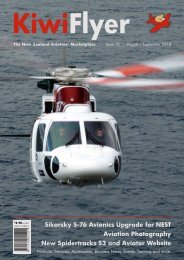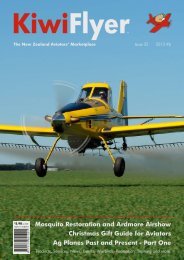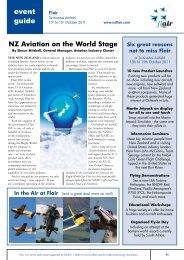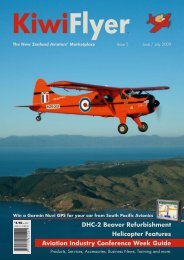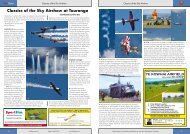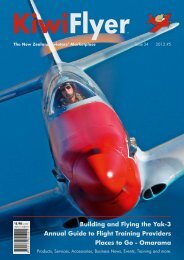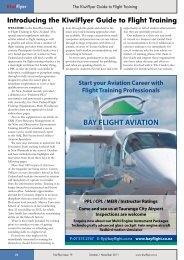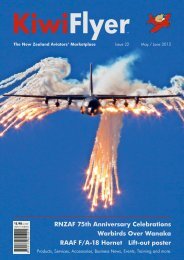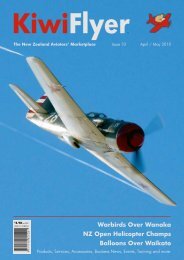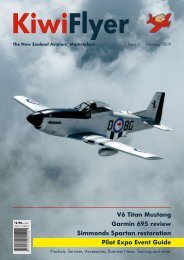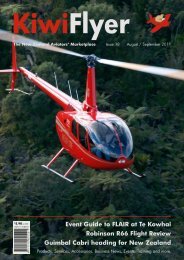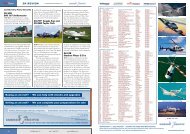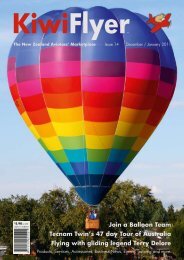Trans Tasman Furio Subsidised Aircraft Tracking Aero ... - KiwiFlyer
Trans Tasman Furio Subsidised Aircraft Tracking Aero ... - KiwiFlyer
Trans Tasman Furio Subsidised Aircraft Tracking Aero ... - KiwiFlyer
You also want an ePaper? Increase the reach of your titles
YUMPU automatically turns print PDFs into web optimized ePapers that Google loves.
<strong>KiwiFlyer</strong> <strong>KiwiFlyer</strong> Feature<br />
<strong>Subsidised</strong> <strong>Aircraft</strong> <strong>Tracking</strong> enhances safety<br />
New Zealand pilots are being encouraged to invest in aircraft tracking systems<br />
with a recently released offer from spidertracks. This is being supported by<br />
Airways NZ, who are subsidising subscription costs for the service as part of<br />
their commitment to enhancing the safety of the GA community.<br />
THE OFFER recognises the important role that aircraft tracking<br />
technology can play in pilot safety by providing a graphic flight<br />
following capability. “Airways has a clear mandate to support this<br />
initiative and that is safety,” says Airways programme manager, Rob<br />
Irwin. “Airways does not actively track GA aircraft on radar when<br />
they are operating outside controlled airspace and there has been<br />
some confusion about that in the GA community. We’re trying to<br />
get the message out there that one of the best ways to guarantee<br />
someone knows where you are is to use a satellite tracking system<br />
and have the information available and displayed on a computer at<br />
home or at the office.”<br />
Every month, Airways deals with an estimated 230 flight<br />
plans going overdue. The number of false alarms generated by<br />
pilots forgetting to amend or terminate their flight plan occupies<br />
resources that should be ready and waiting to help those in genuine<br />
need. In October 2008, Airways surveyed members of the GA<br />
community and found that a large number of respondents were<br />
interested in finding out more about satellite based aircraft tracking<br />
systems.<br />
“From the feedback we received and subsequent conversations,<br />
there was a general trend towards options that would enable the GA<br />
community to look after themselves and potentially enjoy a greater<br />
level of comfort than Airways currently provides,” says Mr Irwin.<br />
The spidertracks offer enables owners of ZK-registered aircraft<br />
THE IDEA for spidertracks was formed in 2005 when Michael<br />
Erceg, a New Zealand businessman flying his helicopter between<br />
Auckland and Queenstown went missing, resulting in an extensive<br />
two week search.<br />
Manawatu engineer and helicopter pilot Don Sandbrook saw an<br />
opportunity to develop a tracking system that<br />
would enable overdue aircraft to be found<br />
quickly and easily, regardless of whether their<br />
locator beacons were activated or not. He<br />
searched the world for a suitable system and<br />
realising there was no inexpensive, portable<br />
and simple solution on the market, set about<br />
creating one.<br />
With engineer James McCarthy,<br />
Don combined a GPS position receiver and<br />
separate transmitter into one unit without the<br />
need for external antenna, thus creating a very<br />
portable, affordable tracking device. The solution offered global<br />
coverage that can be used by anyone, everywhere. The patented<br />
technology was partnered with the global Iridium Satellite network<br />
to transmit data to internet-based tracking software.<br />
The first spider tracking solution was sold to Taupo Eurocopter<br />
owner Bruce Bartley. Recognising the potential of the business,<br />
Bruce offered to invest in the product and Spidertracks Limited was<br />
established with Don, James and Bruce as equal partners.<br />
The spidertracks story<br />
spidertracks is small, elegant and portable<br />
spidertracks screen image showing internet based aircraft tracking in action<br />
to purchase a spidertracks satellite tracking device for only $1295<br />
(plus GST) and receive a free keypad. The package is usually priced<br />
at $3300. Airways will support the purchase by way of covering<br />
the first six months subscription to the satellite network, which is<br />
normally USD19.95 per month.<br />
Spidertracks marketing manager Rachel Donald says the<br />
response to the offer, launched at the recent Pilot Expo, has been<br />
very positive. “We’re very excited to be able to make our system<br />
accessible to all New Zealand pilots and they’re jumping at the<br />
chance to purchase at such an affordable price.”<br />
As the first to offer a truly portable satellite tracking system<br />
that can be easily installed by users, spidertracks opened up a new<br />
market and created demand for simple, cost-effective systems.<br />
It now has an established global client base, providing tracking<br />
solutions for aircraft fleets across Australasia, North America<br />
and Europe, Asia and Antarctica. Being<br />
Automated Flight Following (AFF) accredited,<br />
clients also include contractors to the United<br />
States and Canadian fire and forestry services.<br />
The company is focused on product ease<br />
of use and long term reliability. The latest<br />
materials and technology are utilised, with<br />
ISO9002 certification helping to ensure that<br />
high manufacturing standards are maintained.<br />
In 2008 a global distribution deal was<br />
signed with Cessna <strong>Aircraft</strong>. This has opened<br />
up further markets and opportunities for the<br />
company. Spidertracks is now in use in 30 countries and though it<br />
was developed for the aviation industry, it has also been applied to<br />
marine and land-based operations from Antarctica to Mongolia.<br />
While primarily a safety device, spidertracks is increasingly being<br />
used as a planning and logistics aid by fleet operators around the<br />
world. The company was recently awarded the Supreme Winner<br />
honour at the 2008 Manawatu Business Awards, recognising it’s<br />
rapid growth and successful strategies.<br />
4 <strong>KiwiFlyer</strong> Issue 4 April / May 2009 www.kiwiflyer.co.nz<br />
<strong>KiwiFlyer</strong> Feature<br />
User Testimonial<br />
spidertracks at HELiPRO<br />
HELiPRO is one of the country’s largest aviation operators,<br />
with 35 helicopters and 15 fixed wing aircraft. They have bases in<br />
Palmerston North, Wellington, Paraparaumu, Christchurch, Rotorua<br />
and Taupo. A third of their business is in tourism, a third flight<br />
training and a third commercial operations including firefighting,<br />
lifting and powerline operations in New Zealand and in Australia.<br />
The company has its own sophisticated flight following system<br />
which it marries to the spidertracks tracking. If a craft is more than<br />
a minute overdue an alarm system is activated across the company<br />
bases. One of the first things they do is click on to spidertracks to<br />
see if the aircraft is still moving and what its last reported position<br />
was. HELiPRO Business Manager John Read explains “If the<br />
situation arose where we haven’t managed to raise the pilot within<br />
15 minutes we would put our own helicopters into the air and send<br />
them to where the spidertracks system recorded their last position,<br />
speed and altitude.”<br />
John says they are committed to the system because it enables<br />
them to identify exactly where an aircraft or helicopter is in the<br />
event of an incident. But, he says, the ease of use is also ideal for<br />
the HELiPRO operation.<br />
“We have spidertracks so we can locate any aircraft in our<br />
fleet at any given time. It’s a vital part of our safety procedures.<br />
But spidertracks is also great because of its ease of use and ease<br />
of installation. We chose spidertracks because it is simple, cost<br />
effective and because there are no installation costs. There are<br />
plenty of units on the market that are quite complex. It doesn’t<br />
need to be complex - we wouldn’t use any more features.”<br />
HELiPRO currently have 17 spidertracks and move them amongst their fleet as<br />
required. They are planning to equip all their aircraft with the system over time.<br />
HELiPRO also make use of the portability of spidertracks. “We<br />
have 17 units in our helicopters and we move them between our<br />
training craft as required. We’re slowly rolling them out across the<br />
whole fleet.”<br />
“And we wanted to support a local company - but it’s gone<br />
beyond that now. The product and the system is superior to<br />
anything else on the market.”<br />
His advice to people looking to purchase a satellite tracking<br />
system is to think about what you are buying it for and not to buy<br />
into a complex system with a lot of extra functions that you may<br />
never use.<br />
Has your business just completed an interesting project? Use <strong>KiwiFlyer</strong> to tell the aviation community. 5


